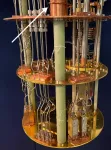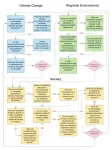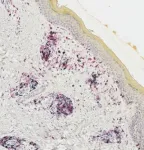(Press-News.org) The secret to building superconducting quantum computers with massive processing power may be an ordinary telecommunications technology - optical fiber.
Physicists at the National Institute of Standards and Technology (NIST) have measured and controlled a superconducting quantum bit (qubit) using light-conducting fiber instead of metal electrical wires, paving the way to packing a million qubits into a quantum computer rather than just a few thousand. The demonstration is described in the March 25 issue of Nature.
Superconducting circuits are a leading technology for making quantum computers because they are reliable and easily mass produced. But these circuits must operate at cryogenic temperatures, and schemes for wiring them to room-temperature electronics are complex and prone to overheating the qubits. A universal quantum computer, capable of solving any type of problem, is expected to need about 1 million qubits. Conventional cryostats--supercold dilution refrigerators--with metal wiring can only support thousands at the most.
Optical fiber, the backbone of telecommunications networks, has a glass or plastic core that can carry a high volume of light signals without conducting heat. But superconducting quantum computers use microwave pulses to store and process information. So the light needs to be converted precisely to microwaves.
To solve this problem, NIST researchers combined the fiber with a few other standard components that convert, convey and measure light at the level of single particles, or photons, which could then be easily converted into microwaves. The system worked as well as metal wiring and maintained the qubit's fragile quantum states.
"I think this advance will have high impact because it combines two totally different technologies, photonics and superconducting qubits, to solve a very important problem," NIST physicist John Teufel said. "Optical fiber can also carry far more data in a much smaller volume than conventional cable."
Normally, researchers generate microwave pulses at room temperature and then deliver them through coaxial metal cables to ¬¬cryogenically maintained superconducting qubits. The new NIST setup used an optical fiber instead of metal to guide light signals to cryogenic photodetectors that converted signals back to microwaves and delivered them to the qubit. For experimental comparison purposes, microwaves could be routed to the qubit through either the photonic link or a regular coaxial line.
The "transmon" qubit used in the fiber experiment was a device known as a Josephson junction embedded in a three-dimensional reservoir or cavity. This junction consists of two superconducting metals separated by an insulator. Under certain conditions an electrical current can cross the junction and may oscillate back and forth. By applying a certain microwave frequency, researchers can drive the qubit between low-energy and excited states (1 or 0 in digital computing). These states are based on the number of Cooper pairs--bound pairs of electrons with opposite properties--that have "tunneled" across the junction.
The NIST team conducted two types of experiments, using the photonic link to generate microwave pulses that either measured or controlled the quantum state of the qubit. The method is based on two relationships: The frequency at which microwaves naturally bounce back and forth in the cavity, called the resonance frequency, depends on the qubit state. And the frequency at which the qubit switches states depends on the number of photons in the cavity.
Researchers generally started the experiments with a microwave generator. To control the qubit's quantum state, devices called electro-optic modulators converted microwaves to higher optical frequencies. These light signals streamed through optical fiber from room temperature to 4K (minus 269 ?C or minus 452 ?F) down to 20 milliKelvin (thousandths of a Kelvin) where they landed in high-speed semiconductor photodetectors, which converted the light signals back to microwaves that were then sent to the quantum circuit.
In these experiments, researchers sent signals to the qubit at its natural resonance frequency, to put it into the desired quantum state. The qubit oscillated between its ground and excited states when there was adequate laser power.
To measure the qubit's state, researchers used an infrared laser to launch light at a specific power level through the modulators, fiber and photodetectors to measure the cavity's resonance frequency.
Researchers first started the qubit oscillating, with the laser power suppressed, and then used the photonic link to send a weak microwave pulse to the cavity. The cavity frequency accurately indicated the qubit's state 98% of the time, the same accuracy as obtained using the regular coaxial line.
The researchers envision a quantum processor in which in which light in optical fibers transmits signals to and from the qubits, with each fiber having the capacity to carry thousands of signals to and from the qubit.
INFORMATION:
Paper: F. Lecocq, F. Quinlan, K. Cicak, J. Aumentado, S.A. Diddams and J.D. Teufel. Control and readout of a superconducting qubit using a photonic link. Nature. March 25. Posted online March 24.
As the signs of today's human-caused climate change become ever more alarming, research into the ways past societies responded to natural climate changes is growing increasingly urgent. Scholars have often argued that climatic changes plunge communities into crisis and provide the conditions that lead societies to collapse, but a growing body of research shows that the impacts of climate change on past populations are rarely so straightforward.
In a new paper published in Nature, scholars in archaeology, geography, history and paleoclimatology present a framework for research into what they term 'the History of Climate and Society' (HCS). The framework uses a series of ...
LEBANON, NH - Some melanoma patients respond very well to immunotherapy, experiencing profound and durable tumor regression. A fraction of these patients will also develop autoimmunity against their normal melanocytes--the cells that give rise to melanoma--a phenomenon called vitiligo. Melanoma survivors with vitiligo have long been recognized as a special group with an outstanding prognosis, and a strong response of immune system cells called T cells.
Immunotherapy researchers at Dartmouth's and Dartmouth-Hitchcock's Norris Cotton Cancer Center (NCCC) led by Mary Jo Turk, PhD, and surgical oncologist Christina Angeles, MD (now of University of Michigan), have discovered how a subset ...
The ocean is dynamic in nature, playing a crucial role as a planetary thermostat that buffer global warming. However, in response to climate change, the ocean has generally become stabler over the past 50 years. Six times stabler, in fact, than previously estimated--as shown by a new study that researchers from the CNRS, Sorbonne University, and IFREMER have conducted within the scope of an international collaboration.* Warming waters, melting glaciers, and disrupted precipitation patterns have created an ocean surface layer cut off from the depths. Just as oil and ...
Training babies' brains and bodies might delay the onset of Rett syndrome, a devastating neurological disorder that affects about 1 in 10,000 girls worldwide.
In experiments with mice that replicate the genetic disorder, scientists discovered that intense behavioral training before symptoms develop staves off both memory loss and motor control decline. Compared to untrained mice, those trained early in life were up to five times better at performing tasks that tested their coordination or their ability to learn, Howard Hughes Medical Institute Investigator Huda Zoghbi and her colleagues report March 24, 2021, in the journal Nature.
Those data, from animals whose symptoms closely mimic the human disease, offers a clear rationale for genetically screening newborns for Rett syndrome, ...
New York, NY (March 24, 2021) -- Immunotherapy is not only significantly less effective in liver cancer patients who previously had a liver disease called non-alcoholic steatohepatitis (NASH), but actually appears to fuel tumor growth, according to a Mount Sinai study published in Nature in March. NASH affects as many as 40 million people worldwide and is associated with obesity and diabetes.
The researchers led a large international collaboration to investigate immunotherapy's effect on hepatocellular carcinoma (HCC), a deadly liver cancer, caused by NASH. They conducted a meta-analysis ...
New scientific findings bring hope that early training during the presymptomatic phase could help individuals with Rett syndrome, a neurodevelopmental disorder, retain specific motor and memory skills and delay the onset of the condition. Researchers at Baylor College of Medicine and the Jan and Dan Duncan Neurological Research Institute at Texas Children's Hospital reported in the journal Nature that, in a mouse model of Rett syndrome, intensive training beginning before symptoms appear dramatically improved the performance of specific motor and memory tasks and substantially delayed the appearance of symptoms.
The researchers propose that newborn genetic testing for Rett syndrome, followed by prompt intensive training in the skills that will be affected, such ...
Immunotherapy using checkpoint inhibitors is effective in around a quarter of patients with liver cancer. However, to date, physicians have been unable to predict which patients would benefit from this type of treatment and which would not. Researchers from the German Cancer Research Center have now discovered that liver cancer caused by chronic inflammatory fatty liver disease does not respond to this treatment. On the contrary: in an experimental model, this type of immunotherapy actually promoted the development of liver cancer, as now reported in the journal Nature.
Liver cancer is the sixth most common type of cancer in the world, ...
The heart of any computer, its central processing unit, is built using semiconductor technology, which is capable of putting billions of transistors onto a single chip. Now, researchers from the group of Menno Veldhorst at QuTech, a collaboration between TU Delft and TNO, have shown that this technology can be used to build a two-dimensional array of qubits to function as a quantum processor. Their work, a crucial milestone for scalable quantum technology, was published today in Nature.
Quantum computers have the potential to solve problems that are impossible to address with classical computers. Whereas current ...
HOUSTON ? Overcoming previous technical challenges with single-cell DNA (scDNA) sequencing, a group led by researchers at The University of Texas MD Anderson Cancer Center has developed a novel method for scDNA sequencing at single-molecule resolution. This technique revealed for the first time that triple-negative breast cancers undergo continued genetic copy number changes after an initial burst of chromosome instability.
The findings, published today in Nature, offer an accurate and efficient new approach for sequencing hundreds of individual cancer cells while also providing novel insights into cancer evolution. These insights may explain why treatments are ...
Joint press release by the German Cancer Research Center, University Medicine Mannheim, Heidelberg University Hospital, and the National Center for Tumor Diseases (NCT) Heidelberg
Tumor vaccines can help the body fight cancer. Mutations in the tumor genome often lead to protein changes that are typical of cancer. A vaccine can alert the patients' immune system to these mutated proteins. For the first time, physicians and cancer researchers from Heidelberg and Mannheim have now carried out a clinical trial to test a mutation-specific vaccine against malignant brain tumors. The vaccine proved to be safe and triggered the desired immune response in the tumor tissue, as the team now reports in the journal Nature.
Diffuse ...



